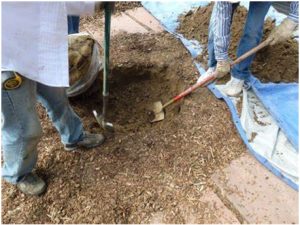As gardeners, we read many instructional and informational articles, posts and books about how to improve our yards and gardens. The following information may help you decipher unfamiliar terms frequently used. You can put all these terms to use when you come to the Permian Basin Master Gardener plant sale on April 15. Knowing what these terms mean will help you pick out the right plant for the right space! Plants that are “happy” will thrive!
Annual: A plant that lives for only one growing season. Annuals flower and seed out in one season dying after they have set seeds or with the first freeze. Bluebonnets, marigolds, zinnias, and vegetable crops like corn and beans are annuals and need to be planted from seed each year.
Perennial: A plant that grows for two or more seasons. Grown in the favorable conditions, perennials will continue to grow from year to year without having to be replanted. the top part of the plant may die but will come back from the roots. Blue mist, daylilies, blackberries, and peaches are all perennials.

These terms will help you determine the habit, the general structure and shape of plant or how it grows. Together these characteristics will help you determine where in your yard that plant might look good or it’s best use in a landscape. First structure and shape:
- Climbing: Grows with a long stem that attaches and climbs a support.
- Clumping: Grows in a compact mass, clustered together.
- Spreading: Grows low and spread on the ground growing roots at nodes along the stem.
- Trailing: Grows along the ground but does not root along the stem.
- Upright: Taller than it is wide usually having a spikey appearance.
Knowing the shape and form of a plant, these terms help you decide where a particular plant is best used:
- Accent: Used to draw attention to a feature in the landscape.
- Border Plant: Used to create a defined border between features in the yard.
- Container Plant: Used alone or in combination with other plants in pots or raised beds.
- Drift: Grouping plants together across a landscape to create a natural look.
- Ground Cover: Used to cover ground; can be a short or tall plant.
- Hedge: Used as a boundary.
- Ornamental grass: Grasses grown as ornamental plants.
- Rock Garden: Landscaping with rocks, stones, and gravel of any size appropriate to setting. Plants incorporated require little water.
- Screen: Less formal than hedge; used to create privacy, block wind or hide an eyesore.
- Turf grass: Grass that is mowed and maintained as a lawn.
- Wildflower Meadow: Informal area that is made up of native flowers, grasses and plants that grow well together.
Do your homework and come prepared to get the most out of the Permian Basin Master Gardener sale. Mark your calendars for April 15.
If you have questions, call the AgriLife office in Odessa at 498-4071 or in Midland at 686-4700.
Additional information, and our blog for access to past articles, is available at westtexasgardening.org. Click on Resources.




